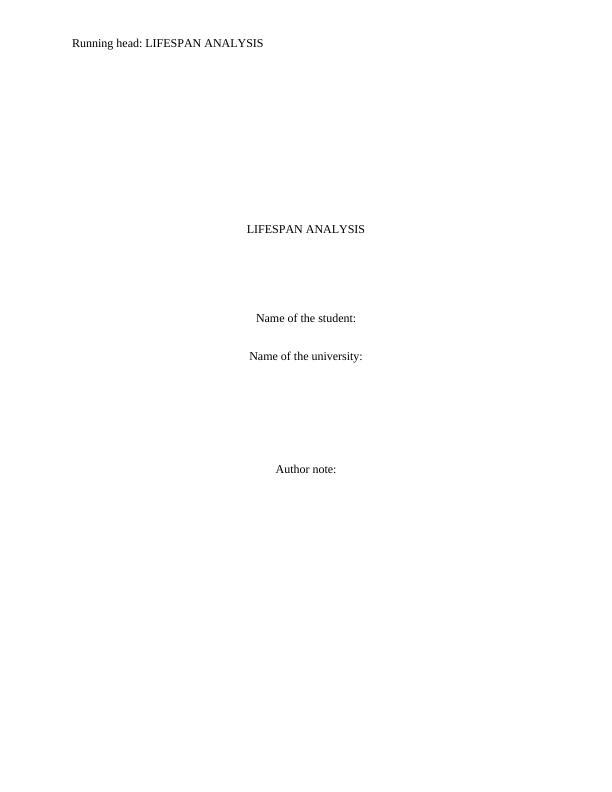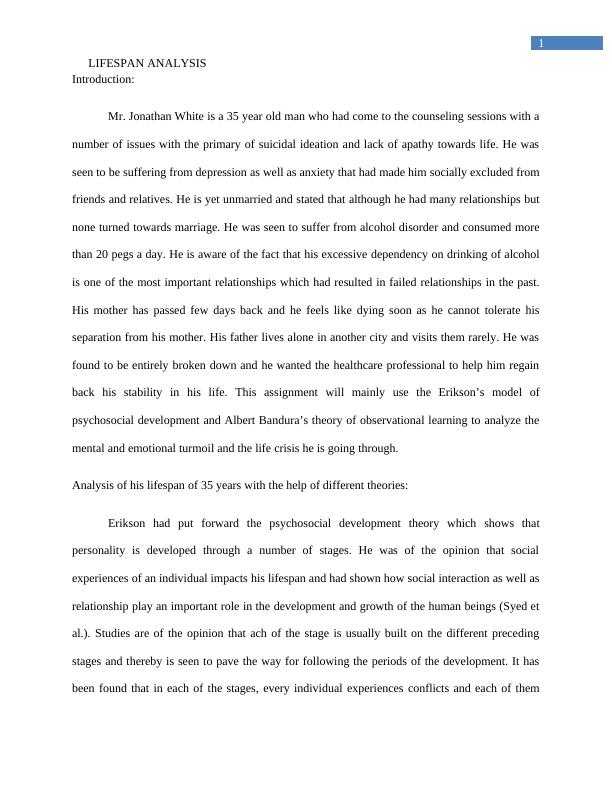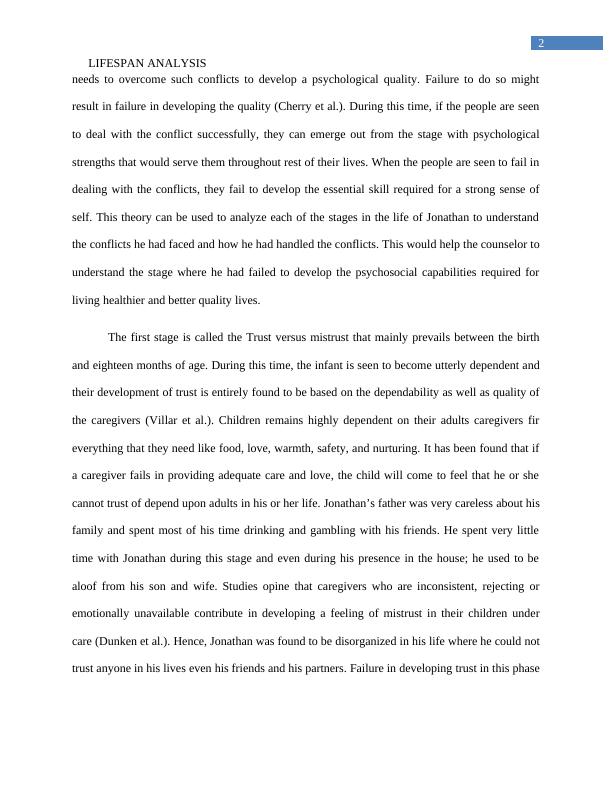Lifespan Analysis: Understanding Mental and Emotional Turmoil
Added on 2023-01-18
10 Pages2877 Words92 Views
Running head: LIFESPAN ANALYSIS
LIFESPAN ANALYSIS
Name of the student:
Name of the university:
Author note:
LIFESPAN ANALYSIS
Name of the student:
Name of the university:
Author note:

1
LIFESPAN ANALYSIS
Introduction:
Mr. Jonathan White is a 35 year old man who had come to the counseling sessions with a
number of issues with the primary of suicidal ideation and lack of apathy towards life. He was
seen to be suffering from depression as well as anxiety that had made him socially excluded from
friends and relatives. He is yet unmarried and stated that although he had many relationships but
none turned towards marriage. He was seen to suffer from alcohol disorder and consumed more
than 20 pegs a day. He is aware of the fact that his excessive dependency on drinking of alcohol
is one of the most important relationships which had resulted in failed relationships in the past.
His mother has passed few days back and he feels like dying soon as he cannot tolerate his
separation from his mother. His father lives alone in another city and visits them rarely. He was
found to be entirely broken down and he wanted the healthcare professional to help him regain
back his stability in his life. This assignment will mainly use the Erikson’s model of
psychosocial development and Albert Bandura’s theory of observational learning to analyze the
mental and emotional turmoil and the life crisis he is going through.
Analysis of his lifespan of 35 years with the help of different theories:
Erikson had put forward the psychosocial development theory which shows that
personality is developed through a number of stages. He was of the opinion that social
experiences of an individual impacts his lifespan and had shown how social interaction as well as
relationship play an important role in the development and growth of the human beings (Syed et
al.). Studies are of the opinion that ach of the stage is usually built on the different preceding
stages and thereby is seen to pave the way for following the periods of the development. It has
been found that in each of the stages, every individual experiences conflicts and each of them
LIFESPAN ANALYSIS
Introduction:
Mr. Jonathan White is a 35 year old man who had come to the counseling sessions with a
number of issues with the primary of suicidal ideation and lack of apathy towards life. He was
seen to be suffering from depression as well as anxiety that had made him socially excluded from
friends and relatives. He is yet unmarried and stated that although he had many relationships but
none turned towards marriage. He was seen to suffer from alcohol disorder and consumed more
than 20 pegs a day. He is aware of the fact that his excessive dependency on drinking of alcohol
is one of the most important relationships which had resulted in failed relationships in the past.
His mother has passed few days back and he feels like dying soon as he cannot tolerate his
separation from his mother. His father lives alone in another city and visits them rarely. He was
found to be entirely broken down and he wanted the healthcare professional to help him regain
back his stability in his life. This assignment will mainly use the Erikson’s model of
psychosocial development and Albert Bandura’s theory of observational learning to analyze the
mental and emotional turmoil and the life crisis he is going through.
Analysis of his lifespan of 35 years with the help of different theories:
Erikson had put forward the psychosocial development theory which shows that
personality is developed through a number of stages. He was of the opinion that social
experiences of an individual impacts his lifespan and had shown how social interaction as well as
relationship play an important role in the development and growth of the human beings (Syed et
al.). Studies are of the opinion that ach of the stage is usually built on the different preceding
stages and thereby is seen to pave the way for following the periods of the development. It has
been found that in each of the stages, every individual experiences conflicts and each of them

2
LIFESPAN ANALYSIS
needs to overcome such conflicts to develop a psychological quality. Failure to do so might
result in failure in developing the quality (Cherry et al.). During this time, if the people are seen
to deal with the conflict successfully, they can emerge out from the stage with psychological
strengths that would serve them throughout rest of their lives. When the people are seen to fail in
dealing with the conflicts, they fail to develop the essential skill required for a strong sense of
self. This theory can be used to analyze each of the stages in the life of Jonathan to understand
the conflicts he had faced and how he had handled the conflicts. This would help the counselor to
understand the stage where he had failed to develop the psychosocial capabilities required for
living healthier and better quality lives.
The first stage is called the Trust versus mistrust that mainly prevails between the birth
and eighteen months of age. During this time, the infant is seen to become utterly dependent and
their development of trust is entirely found to be based on the dependability as well as quality of
the caregivers (Villar et al.). Children remains highly dependent on their adults caregivers fir
everything that they need like food, love, warmth, safety, and nurturing. It has been found that if
a caregiver fails in providing adequate care and love, the child will come to feel that he or she
cannot trust of depend upon adults in his or her life. Jonathan’s father was very careless about his
family and spent most of his time drinking and gambling with his friends. He spent very little
time with Jonathan during this stage and even during his presence in the house; he used to be
aloof from his son and wife. Studies opine that caregivers who are inconsistent, rejecting or
emotionally unavailable contribute in developing a feeling of mistrust in their children under
care (Dunken et al.). Hence, Jonathan was found to be disorganized in his life where he could not
trust anyone in his lives even his friends and his partners. Failure in developing trust in this phase
LIFESPAN ANALYSIS
needs to overcome such conflicts to develop a psychological quality. Failure to do so might
result in failure in developing the quality (Cherry et al.). During this time, if the people are seen
to deal with the conflict successfully, they can emerge out from the stage with psychological
strengths that would serve them throughout rest of their lives. When the people are seen to fail in
dealing with the conflicts, they fail to develop the essential skill required for a strong sense of
self. This theory can be used to analyze each of the stages in the life of Jonathan to understand
the conflicts he had faced and how he had handled the conflicts. This would help the counselor to
understand the stage where he had failed to develop the psychosocial capabilities required for
living healthier and better quality lives.
The first stage is called the Trust versus mistrust that mainly prevails between the birth
and eighteen months of age. During this time, the infant is seen to become utterly dependent and
their development of trust is entirely found to be based on the dependability as well as quality of
the caregivers (Villar et al.). Children remains highly dependent on their adults caregivers fir
everything that they need like food, love, warmth, safety, and nurturing. It has been found that if
a caregiver fails in providing adequate care and love, the child will come to feel that he or she
cannot trust of depend upon adults in his or her life. Jonathan’s father was very careless about his
family and spent most of his time drinking and gambling with his friends. He spent very little
time with Jonathan during this stage and even during his presence in the house; he used to be
aloof from his son and wife. Studies opine that caregivers who are inconsistent, rejecting or
emotionally unavailable contribute in developing a feeling of mistrust in their children under
care (Dunken et al.). Hence, Jonathan was found to be disorganized in his life where he could not
trust anyone in his lives even his friends and his partners. Failure in developing trust in this phase

End of preview
Want to access all the pages? Upload your documents or become a member.
Related Documents
Psychology: Understanding Childhood Characteristics and Developmentlg...
|9
|2229
|45
Theory of Erikson | Psychologylg...
|5
|694
|16
Human Relationships and Life Transitions: Understanding Psychosocial Development in Early Childhoodlg...
|6
|1746
|59
Psychosocial Development in Children: A Case Study of Andrewlg...
|8
|1607
|478
Comparison Between Erikson’s Psychological theory and Bowlby’s Attachment Theorylg...
|6
|1604
|423
Development of psychosocial skills in childrenlg...
|6
|1727
|80
